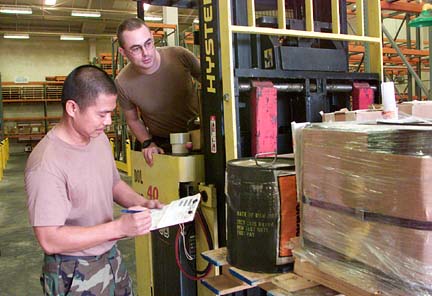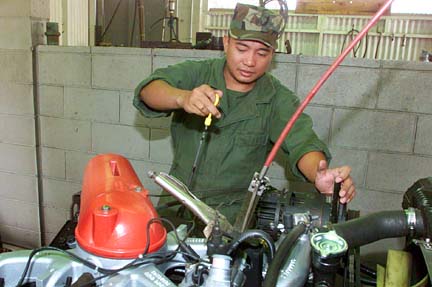


|
Island reservists It used to take Sgt. 1st Class Magno Manzano nearly an hour to make the morning drive from Ewa Beach to Shafter Flats fighting the commute traffic each time.
called to duty
Active duty changes the lives
of 105 local army reservistsBy Gregg K. Kakesako
gkakesako@starbulletin.comNow Manzano doesn't have any traffic to deal with and his commute time has been cut in half, when his duty station changed from Shafter Flats to Schofield Barracks.
That was one of the many changes for Manzano and 105 of his colleagues in the Army Reserve since they were activated for homeland defense shortly after the Sept. 11 terrorist attacks in two mainland cities.

|
And the list of Pacific area Army reservists is expected to grow, according to one Pentagon official.At 30 commercial airports, including those in Hawaii, National Guard soldiers patrol the corridors, checkpoints and other vital areas.
More than 57,000 National Guard and reservists from all services have been forced to place their civilian lives on hold and, in some cases, forego higher salaries since Sept. 11.
In the past decade, reservists have served as peacekeepers in Somalia, Haiti, Bosnia and Kosovo. They have stood as security guards at the Panama Canal, helped Central American nations recover from two hurricanes and enforced the no-fly zone over Iraq.
More than 265,000 reservists were activated during the Persian Gulf War; 37,000 were mobilized during just two years of the Vietnam War; and 938,000 reservists were active during the Korean War from 1950 to 1953.
The 1990-91 Persian Gulf War involved reservists on the front lines and in support roles. Some were among the U.S. casualties of that war.
Most of the 105 Army Reservists from Hawaii and the more than 500 Hawaii Air and Army National Guard soldiers and airmen have remained in the islands.
However, one Army Reserve colonel, Robert Fishman, had to give up his job as chief executive officer of the Hawaii Tourism Authority to report to active duty in the Pentagon.

|
Since Nov. 5 Fishman has been working in the Office of the Chief of Army Reserve working on homeland defense."It's a new era for everyone," said Fishman who was here this weekend to participate in a Fort Shafter Army Reserve management conference.
Fishman said he is part of a team of senior Army reserve officers whose job is "to articulate how the Army Reserve will respond to this challenge."
He noted that the Army Reserves has much of the Army's medical, public affairs, and chemical and biological detection resources.
Army Reserve Staff Sgt. Miles Morita, a Mililani Middle School history teacher, was told to report to Fort Shafter as an intelligence analysis specialist.
"My job is to basically analyze information," said Morita, a 19-year active Army and reserve veteran, "to see what is valuable for the command at Fort Shafter."
Morita, who is fluent in Japanese, also had to give up a part-time waiter job at a Waikiki Japanese restaurant.
Manzano, 38, said although he is on active duty for about a year, he does not see much of a change from his regular job as a technician with the Army Reserve. At Shafter Flats, he used to be a heavy mobile equipment inspector for the Army Reserve.
Now working for the Schofield Barracks' Directorate of Logistics, Manzano said his job is to control the flow of petroleum products for Army units here.
Sgt. Ethan Downs, 27, said that his military job is similar to what he used to do for Fleming Foods as a civilian. In the Army Reserve and now as part of the force assigned to warehouse operations at Schofield's East Range, Downs is a supply sergeant.
Both Manzano and Downs said they are making more money since being activated Oct. 19 than they were earning in civilian life.
Staff Sgt. Eugenio Lactaoen, a Desert Storm veteran, said his active duty pay has a cost-of-living allowance, housing subsistence payments and other allowances. Lactaoen, 36, joined the Army Reserve in 1996 after serving for five years in the Army as an infantry soldier. In the Army Reserve he is a mechanic and inspector of heavy equipment.
Lactaoen said he joined the reserves never expecting to be recalled to active duty, but after the Sept. 11 attacks, he knew everything had changed.
Curtis Matsuura, supervisor at Schofields' motor pool where Lactaoen now works, said the two Army Reservist who were assigned to his labor force of 17 civilians are "real assets."
"We can really use them," Matsuura said, "because we're short handed."
Matsuura noted the Army Reservists "have mechanical backgrounds, so they really help out in our maintenance and repair operations."